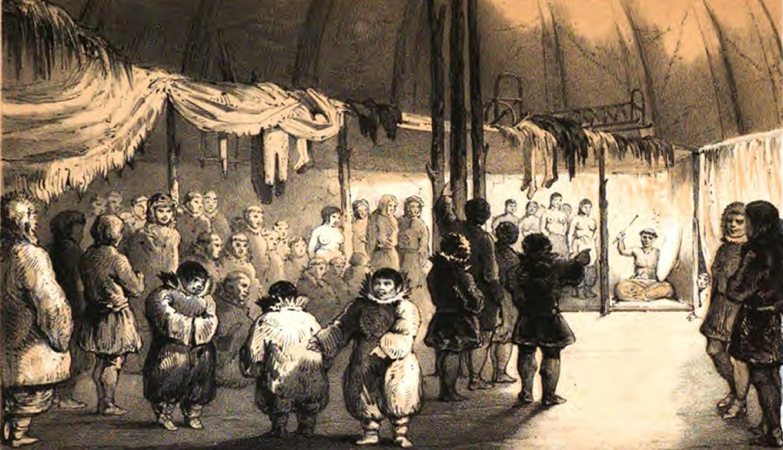
When the Russians arrived in the far north-east of Siberia, the land called Chukotka, in the 17th and 18th centuries, the Chukchi had only stone-age weapons and bone armour. But the Russians failed to conquer them.
At this time, they mainly lived by the coast, by hunting, fishing and whaling, much as their Eskimo (Inuit) neighbours. They wore fur clothes, the men in parka and trousers and women in a jumpsuit with a scoop neckline so they could pull it down easily.
Hooper (see references) believed that the word Chukchi, was a misapprehension of Tuski, meaning a confederation - and that the Chukchi as he met them at the beginning of the 19th century, were a confederation of tribes. He was probably correct in this as the Chukchi tribes had come under pressure from populations spreading north and were very warlike in consquence. One of the main tribes was the Luoravetlan, after which the language and sometimes the name of the place and people may be called.
People have inhabited this region for a very long time as shown by the archaeology.
Recently DNA from the remains of a man from the Saqqaq culture who had lived in Greenland about 4,000 years ago, revealed that the Saqqaq were related to the Chukchi, and not to the more recent Greenland Inuit or to the people of North America. This showed that people from North-East Siberia had migrated right across the Arctic to Greenland about 5,500 years ago.
The Chukchi had continued to travel and trade in their Arctic home. When still remote and unknown to Europeans they had been crossing the Bering Straits for centuries, to trade with Native American tribes. Products for trade things like polar fox furs, were offered at the end of the long Chukchi lance. With this hard spike pointing at his chest the trader was inclined to honesty. In this way American products entered Asia, and further, and had done so via this route for thousands of years.
Unlike the Native Americans, many Chukchi moved inland and acquired herds of reindeer. Reindeer herds have to roam widely in search of pasture and their owners had to travel with them making their home in a large skin covered tent called a yaranga. These always were constructed with their entrance facing the north-east - the direction of the morning dawn.
The Chukchi Directions of time and space

Inside, a square inner tent, lit and warmed by oil lamps was used for living room and bedroom. In the evenings the family with their guests would crowd into here, naked in the steaming fug, to eat their meals, entertain themselves, watch the shaman perform, get stoned by chewing magic mushrooms (the red ones with white spots), use a bucket in the room rather than go outside in the cold, keep up their intoxication by drinking their urine, and sleep together in a communal bed while the baby cried for attention from its cradle hanging from the ceiling.
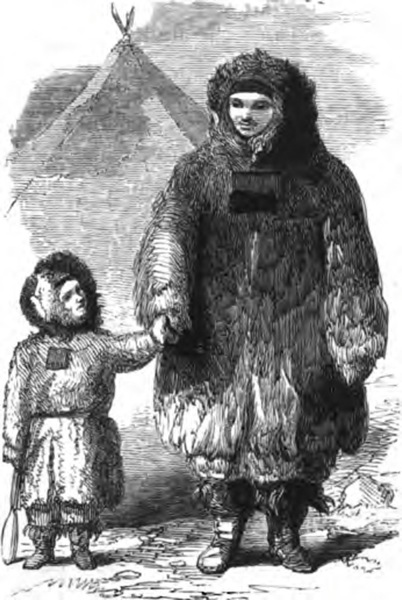 It was a hard life for women, who had to be strong. The fur jumpsuit would get in the way while she was working, so she was partly naked, displaying her tattoos. When they became too old to do the chores, they were killed by their children. The housewife was first up on cold winter mornings to light the fire in the outer part of the yaranga. This took at least twenty minutes with a fireboard - and the women were extemely grateful when the crew of HMS Plover arrived with matches.
It was a hard life for women, who had to be strong. The fur jumpsuit would get in the way while she was working, so she was partly naked, displaying her tattoos. When they became too old to do the chores, they were killed by their children. The housewife was first up on cold winter mornings to light the fire in the outer part of the yaranga. This took at least twenty minutes with a fireboard - and the women were extemely grateful when the crew of HMS Plover arrived with matches.
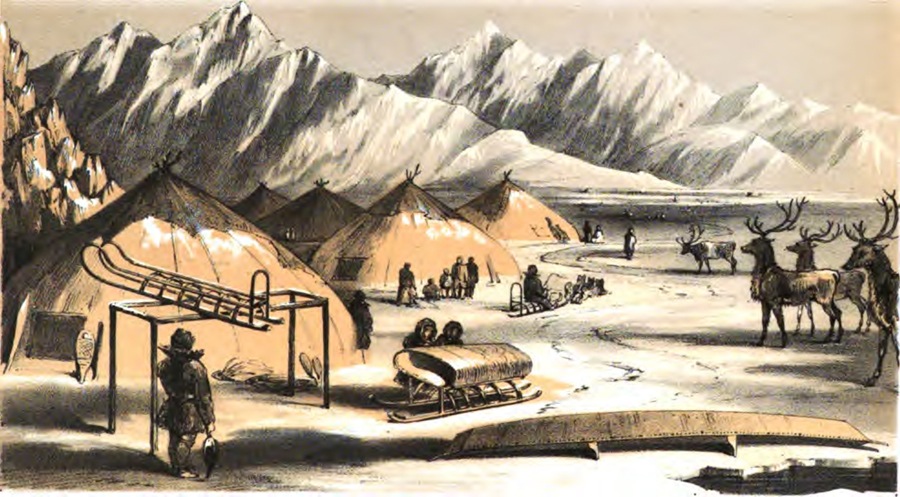
The HMS Plover arrived at Chukotka in 1848, to overwinter, on its way to search for Franklin's expedition. The crew were to remain for ten months. Meanwhile Franklin and his men had perished. The captain was court-martialled on their return, accused of going on sleighrides with his Chukchi mistress, instead of searching for Franklin.
The crew of the Plover were not the first English sailors to meet with the Chukchi - Captain Cook's expedition in the North Pacific had a meeting with some Chukchi in 1778 who entertained them with folk dancing etc. Other British ships also encountered Chukchi hospitality. Many whalers found there way up there. And many Chukchi children were to have English names like Elizabeth and Robert - still popular in North East Siberia today.
In the tundra of the Arctic all the plants, even trees, are tiny. During the long dark winter there is only the wind and the snow and the wind is part of Chukchi music. In the short summer when the sun shines all the time, and there is no night, the tundra is a carpet of flowers, everything at once - forget-me-nots and Michaelmas daises together, with rivulets of water running round them.
The Chukchi counted thirteen seasons in a year. Bogoras, 1909, lists them in order from midwinter: 1 - "in the extending" (days), 2 - "in the lengthening", 3- "during (days) grow long" 4.- "in the calving" (of the reindeer), 5- "in the new summer growing", 6. "in the first summer", 7 - "in the second summer", 8- "in the middle summer", 9- "with the fresh air going out", 10- "with the first light frost", 11- "with the new snow", 12- "in the autumn", 13- "in the winter".
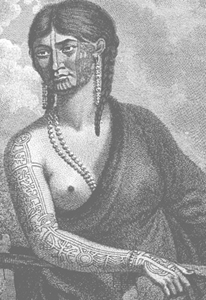
If you have that many seasons you may as well count them by the moon. Here is the story of the girl who forced the Moon to work for man. This story can be found in Bogoras, The Chukchee. The picture of the tattooed Chukchi maiden was drawn on the Billings expedition and was one of the illustrations in the book.
There was a girl who was the daughter of a reindeer breeder. Each summer and winter she went with her sled drawn by a large and magic reindeer to watch over the herds. One day her magic reindeer said to her "Watch out! Watch out! The moon wants to carry you off!" The Moon was coming down with two reindeer drawing his sled. The girl's magic reindeer quickly hid her by disguising her as a hump of snow so the Moon could not find her. But they heard the Moon say he would return.
The magic reindeer and the girl dashed back home to their yaranga (the big round Chukchi tent). "Quick, what shall I turn you into before he gets here" asked the reindeer - A stone block, a hammer, a hair on the bed curtain?" They decided that the magic reindeer would change the girl into a lamp, this would prevent the moon from getting too close a look, because the lamp was too much like the moon and the two lights would cancel each other out.
The Moon searched through the reindeer herd and then through the tent, but he could not find the girl. He was just giving up, and had untied his reindeer to start off home, when the girl changed back, jumped up and stuck her head out of the tent door crying out "Here I am! Here I am!". The Moon rushed back inside but the girl had jumped back to the hearth and turned back into the lamp. the Moon could not find her. He went back out, and again the girl looked out of the tent crying "Here I am! Here I am!". Again the Moon looked all over the yaranga for the girl but could not find her. He grew tired.
Then, seeing the Moon weakened, the girl came out, grabbed the Moon, threw him onto his back, bound his legs and pulled him into the yaranga. "Woe is me!" cried out the Moon - "She is going to kill me!". "Well, why not, go ahead, for I wanted to kidnap you! If you want to kill me, kill me. But before I die, put me down inside the sleeping tent, otherwise I shall freeze."
"Nonsense" said the girl scornfully. "How can your freeze. You are always outside in the open air. Stay outside now."
"If I am to stay forever in the cold, " pleaded the Moon - "Let me stay outside. I shall be a light at night for your people if you let me go. I shall tell them the time of the year if you let me go. I shall turn night into day. I shall measure the whole year season by season. First I shall be the Old-Buck-Moon, then Cold-Udder Moon, then Genuine-Udder Moon, Calving Moon, Water Moon, Making-Leaves Moon, Warm-Moon, then Rubbing-off-Velvet (from the new antlers) Moon, Light-Frost Moon, Wild-Reindeer-Rutting Moon, Muscles-of-the-Back Moon (see body calendar), then Shrinking-Days Moon."
"Oh, all right" said the girl. But if I set you free and if you are rested again, and the marrow in your bones is fat and strong once more, won't you come after me again?"
"No, no!" cried the Moon - "I shall not! I have had enough. You are far too lively for me. I shall never leave my home in the sky again. Let me go, and I shall light up." The girl let him go, and he lit up.
In Chukchi cosmology the universe was completely alive and sentient. Everything possessed a living spirit, capable of taking human form at will, the mountains, the clouds, the animals, the birds, household utensils, even excrement.
In the words of a Chukchi shaman (from Bogoras: The Chukchee, 1909)
"All that exists lives. the lamp walks around. the walls of the house have voices of their own. Even the chamber pot has a separate land and house. the skins sleeping in the bags talk at night. the antlers lying on the tombs arise at night and walk in procession around the mounds, while the dead get up and haunt the living."
Spirits could be friendly beings or evil demons frightful to behold. The Sun is a friendly being. Dressed in bright clothes he moves around the sky in his sled drawn by reindeer with shining copper antlers. In the evening the Sun goes down to his wife, "Walking-Around-Woman", who was once a girl on Earth he had carried off to Heaven up one of his own sunbeams.
The direction of the Winds in different regions were all named and were Beings to be prayed to. They had names "Sea Winds", "From the Open Wind", "From the Land Wind" etc.
Knowing the winds was important for navigating across the Arctic seas and the almost featureless tundra. The directions and names of the winds varied according to the region. The Winds were all personified with stories about them.
Naviagators in the Mediterranean also used to identify the direction of named winds. We still use some of the names today. When they began to use the magnetic compass they marked out the names of the winds and their directions on them.
Among the other many friendly beings, the most important - to whom sacrifices were made, were those who presided over the directions of space and time. Each direction, was a time of day, marked by the position of the sun or the prevailing wind.
Each direction also had associated with it, many qualities, and also presiding deities. Since the Chukchi live above the Arctic circle, the hours of the day by the position of the sun vary enormously through the year - only Midday and Midnight being unchanging. The system was also complicated by the great number of divisions of time - Bogoras has a diagram with 22, but there were others. It depended on the time of the year. The divisions of time also depended on the time of day the busy early morning had many more divisions than the night.
Morning-Dawn was the most important direction - the Chukchi homes faced this way. Most of the sacrifices went to the gods of the Morning-Dawn and Midday.
Morning-Dawn, was divided further by the shamans, into Top-of-the-Dawn, Right-Hand-Dawn, Genuine-Dawn and Left-Hand-Dawn.
This division of Dawn into many time zones, was common to other people too. Close observation of the sky at dawn by the shamans was not merely to tell it was time to start the day, but to enable them to forecast the weather for that day. This was vital for a maritime nation traditionally dependent on sea-fishing and whaling, as most Chukchi were.
Their neighbours the Aleuts on the chain of islands connecting Asia and America across the north Pacific, were said to have been able to forecast the weather very well. They looked for signs at sunset and then at dawn, and from these could tell what sort of day was coming. They watched the change of colour of the dawn sky so attentively that they said this was "to speak with the sun and the dawn".
The personification and dividing of dawn is also found in Homer's Odyssey. The days begin with "Rosy-Fingered-Dawn" who is followed by "Golden-Throned-Dawn". Both are not only hours at the beginning of the day, but goddesses leaving their husbands in bed as they have to get up early and do their rounds on their chariots. In Greek mythology, Dawn (Eos) was married to the Dawn-Wind and their child was the Morning-Star.
The Chukchi Dawns also had a home-life, as did all the Directions or hours. Each Direction lived in his or her own world where he or she received sacrifices. there were many more worlds in the Chukchi universe, both above and below the middle Earth where us humans live. Only shamans and spirits could travel through space from one world to another by way of the tunnel under the Pole Star.
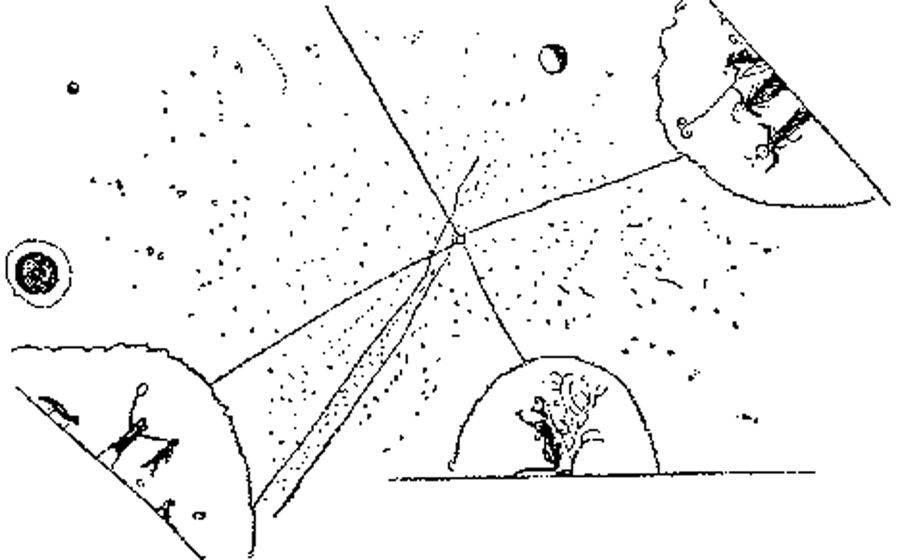
In the Chukchi drawing of the universe in Bogoras, the Pole Star can be seen in the centre (this is about 1900), with the four main directions radiating from it, and the Milky Way going across. The worlds of Dawn, Evening and Darkness are shown. The world of Dawn, who has rays around his head, is near the sun. He holds in his left hand a tray containing a sacrifice offered to him and in his right hand he holds a fox (foxes are kept in hutches for their fur but then they had to be hunted). To his left a fox is approaching, and on his right, a dog which has been also sacrificed is looking at him. The fox is to be sent down to Earth in exchange for the dog. Dawn has a wife shared with Twilight. There were stories about their complicated love life.
Opposite dawn in this picture, is the world of Evening, near the Moon. Evening and his family are wearing ceremonial costumes to celebrate the Feast of the Sea-God.
Between Dawn and Evening is Darkness, half hidden by a tree.Darkness is the brother of Left-Hand-Dawn.
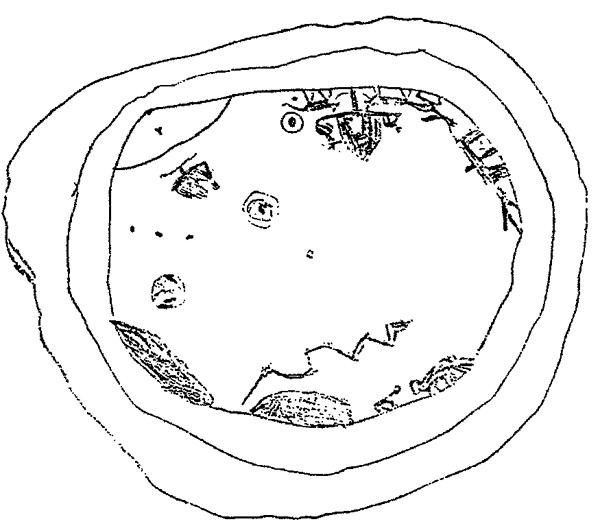 Another picture of the Chukchi universe shows "Left Hand Dawn" living in a wooden house with two "Murdering-Spirits" (who bring disease and death) tied up on either side. In this picture, next to Left-Hand-Dawn, is the house of Genuine-Dawn, on a platform supported by a single pole. Four dogs are tied to the sides of the house. To the right of Genuine-Dawn is a little old woman, Dawn-Top-Woman, who lives in a house of her own - also up a pole. Under her feet is the Morning Star (the planet Venus). This sketch also shows some of the layers of the heavens - as in the concepts of the universe conceived by the Greek astronomers of the Mediterranean, and the Polynesian navigators further south in the Pacific, more than 2,000 years ago.
Another picture of the Chukchi universe shows "Left Hand Dawn" living in a wooden house with two "Murdering-Spirits" (who bring disease and death) tied up on either side. In this picture, next to Left-Hand-Dawn, is the house of Genuine-Dawn, on a platform supported by a single pole. Four dogs are tied to the sides of the house. To the right of Genuine-Dawn is a little old woman, Dawn-Top-Woman, who lives in a house of her own - also up a pole. Under her feet is the Morning Star (the planet Venus). This sketch also shows some of the layers of the heavens - as in the concepts of the universe conceived by the Greek astronomers of the Mediterranean, and the Polynesian navigators further south in the Pacific, more than 2,000 years ago.
Two other Directions were top and bottom or as Bogoras calls them zenith and nadir. Bottom is the Earth God ruler of the world below the sea. Top is the Creator God who can watch all that happens through holes in the sky around the Pole Star. The Pole Star is the "Nail star" unchanging, through the holes the layers of the universe with their other worlds and their stars can be seen changing below the Pole Star. It is a similar concept to the Greek universe which became the foundational system for mediaeval astronomy.
Next in importance to the Pole Star - at the top, were the stars marking the back and front - "Front Head" was Arcturus" and "Rear Head" Vega. These were used along with the other stars to find the direction of travel at night.
All the stars which could be visible were mapped and in constellations with identities and stories about them. The constellation of Orion was a hunter in traditional Chukchi cosmology - an archer - but the three stars of Orion's "belt" were his crooked back and Orion's "sword" was a certain part of his body. The red star Aldebaran was his copper-headed arrow, and the Pleiades were six young women that he was after. Leo represented his estranged wife. It is not very different from the ancient Greek legends. Orion also appears in the skies south of the equator and the southern skies, and their part in early timekeeping and navigation in the Pacific will be put into this website soon.
The Milky Way was the Pebbly River - just as we find in North American cosmologies.
The meteor showers were seen as the gods relieving themselves on the people on Earth (a feeling which is shared by many.
The Raven is one of the oldest surviving Creator Gods. Some legends tell how Raven created the Earth and the People, plants and animals. In other stories Raven is a Trickster and although can appear human, still has a Raven's dirty habits like eating rubbish. Some stories are for telling to children and some are fables, like "How the Raven became Black". Raven stories are found throughout Europe, Asia and North American, so this is a god they may be traced back several thousands of years. the story of how the Raven became black is found in Finnish, Estonian, Slav, Yukaghir and Canadian folklore. The Ravens in the Tower of London have their wings clipped as legend says that if they fly away it would be a disastrous omen for Britain.
The belief in the significance of qualities of the directions in space and time is found in many traditions and cultures and may date back at least 70,000 years. In China it was to lead to the development of the magnetic compass.
For the Chukchi these qualities of time and space were an essential part of life. The Directions were sacrificed to with prayers for assistance.
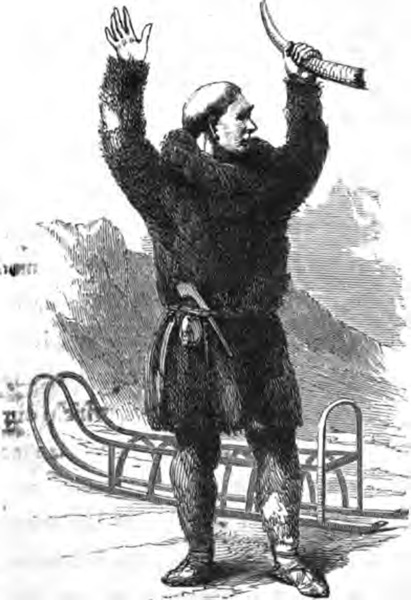 There is a description of the invoking of the aid of the Direction gods, which was experienced by Hooper and two others from the Plover 1848, when they were lost in a blizzard with their Chukchi guides, Mooldooyah, a shaman, (in the picture of the ceremony inside the yaranga) and his wife Yaneenga.
There is a description of the invoking of the aid of the Direction gods, which was experienced by Hooper and two others from the Plover 1848, when they were lost in a blizzard with their Chukchi guides, Mooldooyah, a shaman, (in the picture of the ceremony inside the yaranga) and his wife Yaneenga.
Their Chukchi companions prayed to the Directions, a ceremony which
"not withstanding the simplicity of its details struck me with a sensation of awe, and first opened my eyes to the real danger we were in. Quitting their sledge with slow and measured step, the pair removed to a distance from us, where Yaneenga prostrated herself in the snow, her hands upraised above her buried face; the man turning first to the west then to the north and south, omitting - I know not why, perhaps accidently - the fourth point, bowed himself to each repeatedly; like Yaneenga's, his hands and arms were upraised above his head, and he gave forth a succession of cries, which still sound in my ears as I write of them - long wailing shouts, loud unearthly and despairing, each exhausting the lungs in their emission, like a thunder roll at first, and sinking by degrees to a melancholy faintness. In all my life I never heard any sounds to equal these for horrible impressiveness; the death wail of the Irish, the shout of the Red Indian, both of which I have heard in force, fall far short of Mooldooyah's appeal to his fates".
video of Chukchi shaman ritual from YouTube:
Chukotka updated:
See also
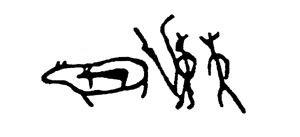 |